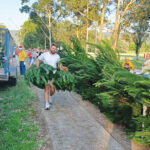Photo of the workers at Brell’s Tannery courtesy of the late Margaret Player.
By Lyn Forde – President/Research Officer of St Marys & District Historical Society Inc.
IN December 1899, two young men named William Chapman and Robert Smeaton who were employed at Martin Brell’s tannery in St Marys went for a trip to the Mountains for the purpose of gathering flowers and ferns where they previously visited the same gully with good success as far as ferns and flowers were concerned. They drove from St Marys in a sulky and after making their horse secure they separated, each going in different directions down the gully. At about half past four William noticed a vile smell and saw the remains of a campfire on the main watercourse near the bottom of the gully and he went to examine it. He soon found the remains of a camp and the body of a dead man in a crouching posture between a ledge of rock and a fallen tree. Satisfied it was the body of a man he returned to the top of the gully coo-eing for Robert and told him what he found. They hurried off to Penrith to inform Sergeant Thorndike. As it was getting dark about this time the Sergeant arranged to make a start the following morning. Shortly before nine o’clock they followed William and Robert that consisted of the Coroner Mr John King Lethbridge, (J.P.), Dr Dundas, Mr Duncan McDonald, Sergeant Thorndike, Constable Brown and three members of the press along with Mr William Fragar and Mr John Price following on with a coffin. Arriving at the top of the gully the horses were taken out of the vehicles and made secure and the descent of the gulley commenced. This proved to be rather more than expected as the descent and ascent would be somewhat difficult. Soon they arrived at the spot where on a flat ledge of rock underneath another ledge they found three newspapers, one of 22nd, 27th and 29th October 1899 and a newspaper contents bill dated October 30th. Just near there they found a envelope bearing a North Sydney stamp of November 1st 1899 and addressed to G Goodfellow, North Sydney S F Company, Circular Quay and lying near it was a pocket plan of Heidelberg Heights, North Shore highlands. On the ledge was an open razor with what appeared to be dots of blood with the rust. A small sugar bag lay on the outside with marks of blood and the bag contained a loaf of bread (rotten), a cylinder oil feeder, a razor case, a parcel of butter, an old felt hat, two old table knifes, pieces of slate, a broken mirror, decayed food and one pair of sheep shears, etc. There was also a billy can, a black-briar pipe, shoulder straps, an old coat, a pair of trousers, a bush rug and part of a tent with several other things. Below the ledge formed by the flat rock and between another ledge and a fallen tree the body could be seen in a crouching or sitting position with the head fallen over onto the left knee. It was dressed in a pair of striped moleskin trousers, striped braces and blucher boots with hob nails, a flannelette shirt, tweed vest, a faded worsted sack coat and a soft felt hat. Preparations were made to examine the body thoroughly by Dr Dundas with disinfectants and Constable Brown and William Fragar went to assist the doctor. On lifting the coat the left arm was in the sleeve and the arm came away with the coat and the head dropped off with the lower jaw separating from the upper. There was also some thick brown hair on the back of the skull, but as nearly all the flesh had gone there was no hope of tracing the features. There was no marks of violence on the skull or any part of the body. The lower jaw had eight irregular sound teeth in front but no back ones, the upper jaw had five sound teeth in front and four sound teeth in the back and one decayed. Dr Dundas said from what he could see he should think the age of the deceased would be between 40 and 60 and he would be about 6ft 8in high. On searching the body there was no papers that could identify him and there was only 2s (shillings) in money. The remains were then put into the coffin and taken to the top and onto Emu Plains General Cemetery where it was buried. At three o’clock the same day a magisterial enquiry was held at the Penrith Court House before the District Coroner Mr J K Lethbridge, J.P., and the following evidence was taken: – Sergeant Thorndike reported “that at 6 p.m. yesterday evening William Chapman of St Marys reported that while in a gully beyond Wasco’s on the Main Western Road he had discovered the dead body and we visited the place and saw the remains of a man in a sitting position in a crevice of a rock. Death must have taken place some time ago”. William Chapman said “that he was a tanner and resided at St Marys and corroborated the Sergeant’s statement. Robert Smeaton had been in his company but was not present when he found the body, but he was down the same gully three weeks ago and he did not see anything then. The remains may have been there then but he could not say”. Dr Dundas said “that this morning he was asked by Sergeant Thorndike to go with him and examine the body of a man found dead near Wascoe and he accompanied the coroner and Sergeant Thorndike and they went to a place pointed out by the last witness (Chapman). He saw the remains of a man in a sitting posture on a rock with his body bent forward in a very advanced stage of decomposition and on making a postmortem examination he found there were no marks of violence. He also saw an open razor about three yards from the body but could not tell whether there were blood marks without a microscopic examination. From the position of the body and probably blood stains on the trousers he should suppose that deceased committed suicide by cutting his throat with a razor but he was not unable to state cause of death definitely”. The coroner’s finding was as follows: – From the evidence, he found that the said deceased (name unknown) was found dead near Wascoe on the Great Western Road on the 26th of November. 1899 without any marks of violence appearing on the body, but how or by what means he came by his death there is not sufficient evidence to enable me to say.
Source – Nepean Times -Saturday 2 December 1899.






